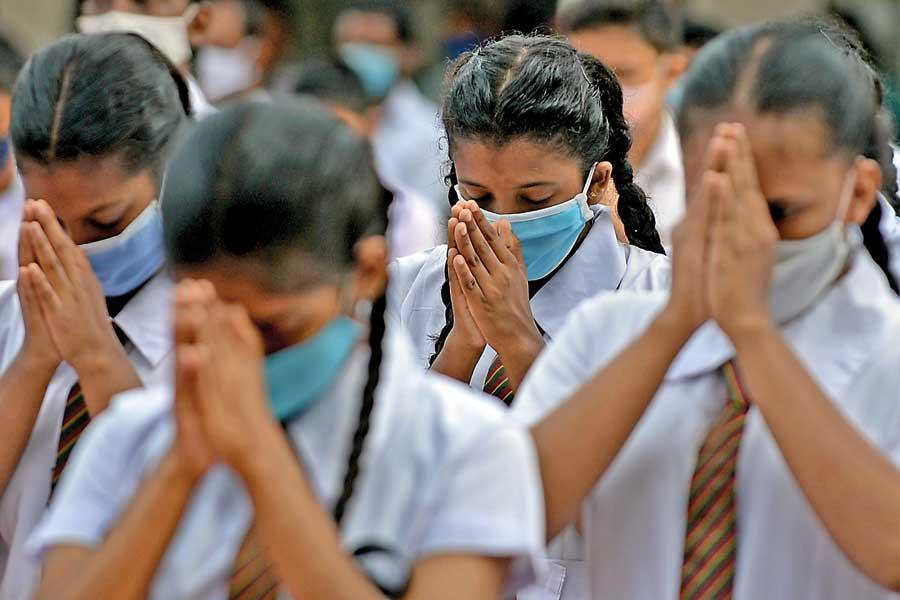02 May 2023 - {{hitsCtrl.values.hits}}

Most school uniforms worn in Sri Lanka were introduced during British rule and have changed very little over the decades.
Sri Lanka is in the hot-humid climate zone, with daytime temperatures ranging over 32C most of the year. The heat wave, which engulfed Sri Lanka in April, has made us more aware of the effects of high air temperature on health and well-being and productivity. Higher air temperature can cause thermal discomfort, making it difficult for people to perform day-to-day tasks and, in extreme cases, result in heat stroke. Clothing can significantly affect thermal comfort, and wearing loose, light-coloured clothing is recommended during hot and sunny days.
wave, which engulfed Sri Lanka in April, has made us more aware of the effects of high air temperature on health and well-being and productivity. Higher air temperature can cause thermal discomfort, making it difficult for people to perform day-to-day tasks and, in extreme cases, result in heat stroke. Clothing can significantly affect thermal comfort, and wearing loose, light-coloured clothing is recommended during hot and sunny days.
Even though adults are at liberty to change their clothing as the weather permits, school children wear a very stringent uniform for at least five hours during the daytime making it challenging to remain thermally comfortable. Most classrooms in cities are crowded and lack natural ventilation, exacerbating thermal discomfort. Therefore, a school uniform suitable for the local climate makes a significant difference instudents’ well-being.
Wearing school uniforms in Sri Lanka serves several purposes. Firstly, it promotes a sense of equality among students, removing distractions that may arise from fashion or clothing choices. Additionally, uniforms aid in identifying students, making it easier for school staff and security to ensure safety on campus. Uniforms are also a more affordable option compared to purchasing trendy clothing for daily wear.
Most school uniforms worn in Sri Lanka were introduced during British rule and have changed very little over the decades. While the current uniforms for boys are acceptable in terms of aiding thermal comfort in the tropics, the same cannot be said about the girls’ school uniforms. Many girls’ schools established before independence still follow a very stringent attire consisting of a white short-sleeved knee-length collared dress buttoned up to the neck, a belt, and a tie. The cotton material and colour are favourable for the tropics, but the design is not.
The lack of reform in girls’ school uniforms since British rule is evident in many girls’ schools
The tie, which is a key element of the girl’s school uniform, is a part of formal British attire and adds an additional layer of clothing to the neck area, specifically designed to increase heat retention and reduce the body’s ability to dissipate heat in cold climates. However, this heat retention only increases thermal discomfort in hot and humid climates. The practice of wearing a tie is often associated with professional or formal dress codes and may be considered a cultural or social norm due to British colonial influence.
It is unfortunate that after 75 years of independence from British colonialism, the tradition of wearing a tie for creating a formal appearance for school is still practised in Sri Lanka, despite its impact on thermal discomfort. The lack of reform in girls’ school uniforms since British rule is evident in many girls’ schools. The Education Administration in Sri Lanka still practises British colonial period standards for school attire, which are in conflict with local climate conditions.
Furthermore, it is essential to note that the issue of increasing air temperature in Sri Lanka is not going away anytime soon due to the effects of Climate Change. It is predicted that the mean annual temperature in the country will increase within the range of 0.47°C-1.08°C by 2030, affecting every aspect of life, especially children who have less control over their well-being than adults.
To address thermal comfort issues, girls’ schools established post-independence have made many climate-friendly adaptations to school uniforms, such as having a white short-sleeved dress with a round or square neck, excluding the tie completely. Another option is to have two different uniforms for the primary and secondary sections of the schools, where younger children would be allowed to wear a much more comfortable but less formal uniform. It is essential to reform the school uniform standards and make them more climate-friendly to ensure children’s thermal comfort, health, and well-being.
The writer is a senior lecturer at the Department of Architecture, University of Moratuwa.
10 Jan 2025 9 minute ago
10 Jan 2025 24 minute ago
10 Jan 2025 2 hours ago
10 Jan 2025 2 hours ago
10 Jan 2025 3 hours ago